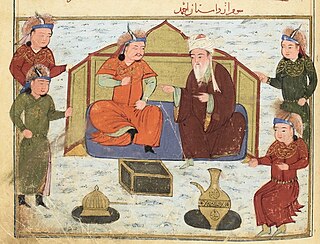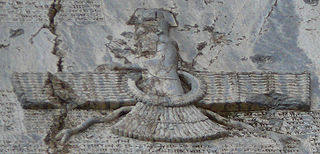
The Anushtegin dynasty or Anushteginids, also known as the Khwarazmian dynasty was a Persianate Sunni Muslim dynasty of Turkic mamluk origin from the Bekdili clan of the Oghuz Turks. The Anushteginid dynasty ruled the Khwarazmian Empire, consisting in large parts of present-day Central Asia, Afghanistan and Iran in the approximate period of 1077 to 1231, first as vassals of the Seljuks and the Qara Khitai, and later as independent rulers, up until the Mongol conquest of the Khwarazmian Empire in the 13th century.

Fakhr al-Din Iraqi was a Persian Sufi poet of the 13th-century. He is principally known for his mixed prose and poetry work, the Lama'at, as well as his divan, most of which were written in the form of a ghazal.

Ahmed Tekuder, also known as Sultan Ahmad, was the sultan of the Persian-based Ilkhanate, son of Hulegu and brother of Abaqa. He was eventually succeeded by his nephew Arghun Khan.
Atâ-Malek Juvayni (1226–1283), in full, Ala al-Din Ata-ullah, was a Persian historian and an official of the Mongol state who wrote an account of the Mongol Empire entitled Tarīkh-i Jahān-gushā.

Hamdallah Mustawfi Qazvini was a Persian official, historian, geographer and poet. He lived during the last era of the Mongol Ilkhanate, and the interregnum that followed.

Rashid al-Din Muhammad ibn Muhammad ibn Abd Jalil al-Umari, better known by his nickname of Vatvat, was a Persian secretary, poet, philologist in the Khwarazmian Empire. In addition to being a prolific author in Arabic and Persian, he also occupied high-ranking offices, serving as the chief secretary and propagandist under the Khwarazmshahs Atsiz and Il-Arslan.
Khwarazmshah was an ancient title used regularly by the rulers of the Central Asian region of Khwarazm starting from the Late Antiquity until the advent of the Mongols in the early 13th-century, after which it was used infrequently. There were a total of four families who ruled as Khwarazmshahs—the Afrighids (305–995), Ma'munids (995–1017), the line of Altuntash (1017–1041), and the most prominent ones, the Anushteginids (1097–1231). Like other contemporary Central Asian titles, such as Afshin and Ikhshid, the title of Khwarazmshah is of Iranian origin.

Ala al-Din wa-l-Dawla Abu'l-Muzaffar Atsiz ibn Muhammad ibn Anushtegin, better known as Atsiz (اتسز) was the second Khwarazmshah from 1127/8 to 1156. He was the son and successor of Muhammad I.

Humam-i Tabrizi, was a Persian Sufi poet of the Ilkhanate era. He was one of the most distinguished figures of his time due to his poetry, teachings, piety, and Sufi spirituality.

Shams al-Din Juvayni was a Persian statesman and member of the Juvayni family. He was an influential figure in early Ilkhanate politics, serving as sahib-i divan under four Mongol Ilkhans−Hulagu, Abaqa, Tekuder and Arghun Khan. In 1284, Arghun accused Shams al-Din of having poisoned the Ilkhan Abaqa, who may actually have died of the effects of alcoholism; Shams al-Din was duly executed and replaced as vizier by Buqa. A skillful political and military leader, Shams al-Din is also known to have patronized the arts. The musician Safi al-Din al-Urmawi was one of those he supported.

The Afrighids were a native Khwarezmian Iranian dynasty who ruled over the ancient kingdom of Khwarezm. Over time, they were under the suzerainty of the Sasanian Empire, the Hephthalite Empire, the Göktürk Khaganate, the Umayyad Caliphate, Abbasid Caliphate and the Samanid Empire.

The Maʾmunids were an independent dynasty of Iranian rulers in Khwarazm. Their reign was short-lived (995–1017), and they were in turn replaced by the expansionist Ghaznavids.

The Khwarazmian or Khwarezmian Empire was a Turko-Persian Sunni Muslim empire that ruled large parts of present-day Central Asia, Afghanistan, and Iran in the approximate period of 1077 to 1231, first as vassals of the Seljuk Empire and the Qara Khitai, and later as independent rulers, up until the Mongol conquest in the 13th century. It is estimated that the empire spanned an area of 2.3 million square kilometers to 3.6 million square kilometers effectively making it one of the largest land empires in history. In the beginning of the 13th century, the empire was the greatest power in the Muslim world. The empire, which was modelled on the preceding Seljuk Empire, was defended by a huge cavalry army composed largely of Kipchak Turks.

Ghiyath al-Din Mahmud, was Sultan of the Ghurid Empire from 1206 to 1212. He was the nephew and successor of Mu'izz al-Din Muhammad.

Baha al-Din Sam II was the fourth ruler of the Ghurid branch of Bamiyan, ruling from 1192 to 1206.
Shams al-din Muhammad Juvayni was a Persian statesman and member of the Juvayni family. He served as the state treasurer (mustawfi) of the Khwarazmshah Ala al-Din Muhammad II and his son Jalal ad-Din Mingburnu.
Sharaf al-Din Harun Juvayni was a Persian statesman and poet from the Juvayni family. He was the son of Shams al-Din Juvayni.

Muzaffar al-Din Uzbek, also known as Özbeg ibn Muhammad Pahlawan was the fifth and last ruler (atabeg) of the Eldiguzids from 1210 to 1225, during the later Seljuk and Khwarezmian periods. He was married to Malika Khatun, widow of Toghrul III, the last sultan of the Seljuk Empire.
Fakhr al-Din Mustawfi was a Persian statesman from the Mustawfi family of Qazvin, who lived during the early Ilkhanate era. He was the elder cousin of the distinguished historian and geographer Hamdallah Mustawfi.
Baha al-Din Baghdadi was a Persian secretary of the Khwarazmshahs, who is notable for his expertise in Persian letter-writing. He served as the head of the divan-e insha (chancellery) under Ala ad-Din Tekish.













